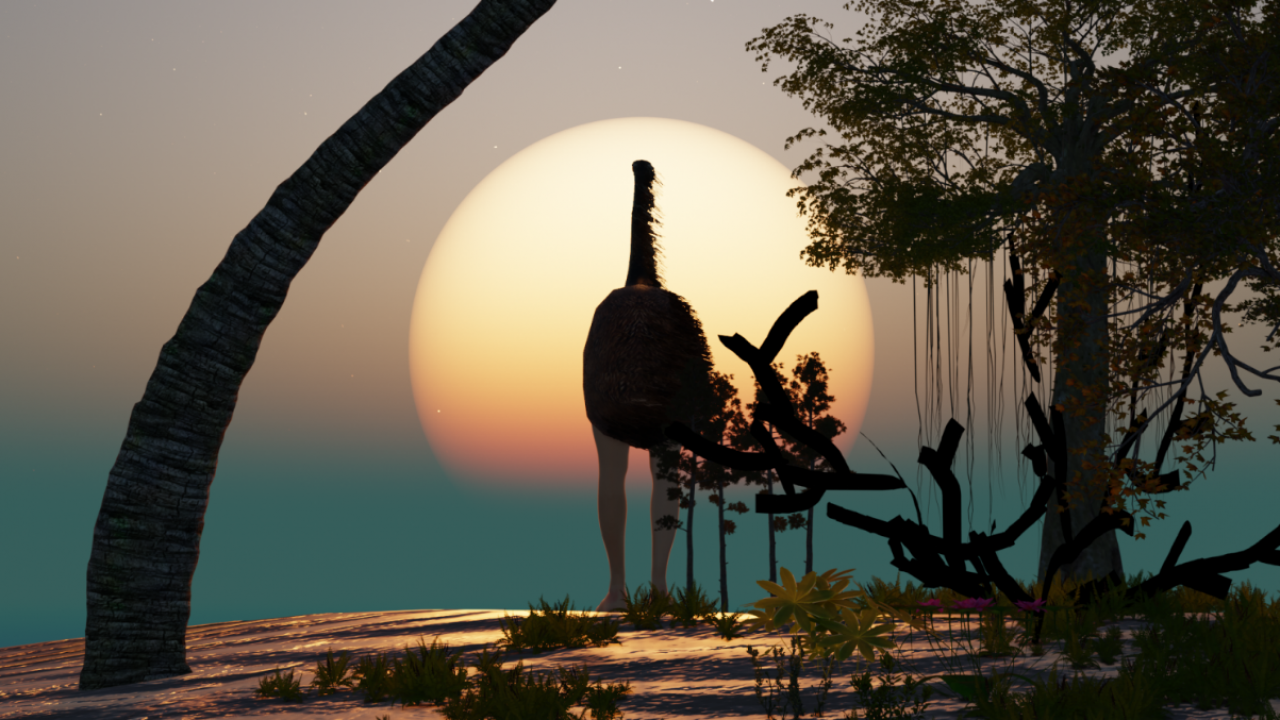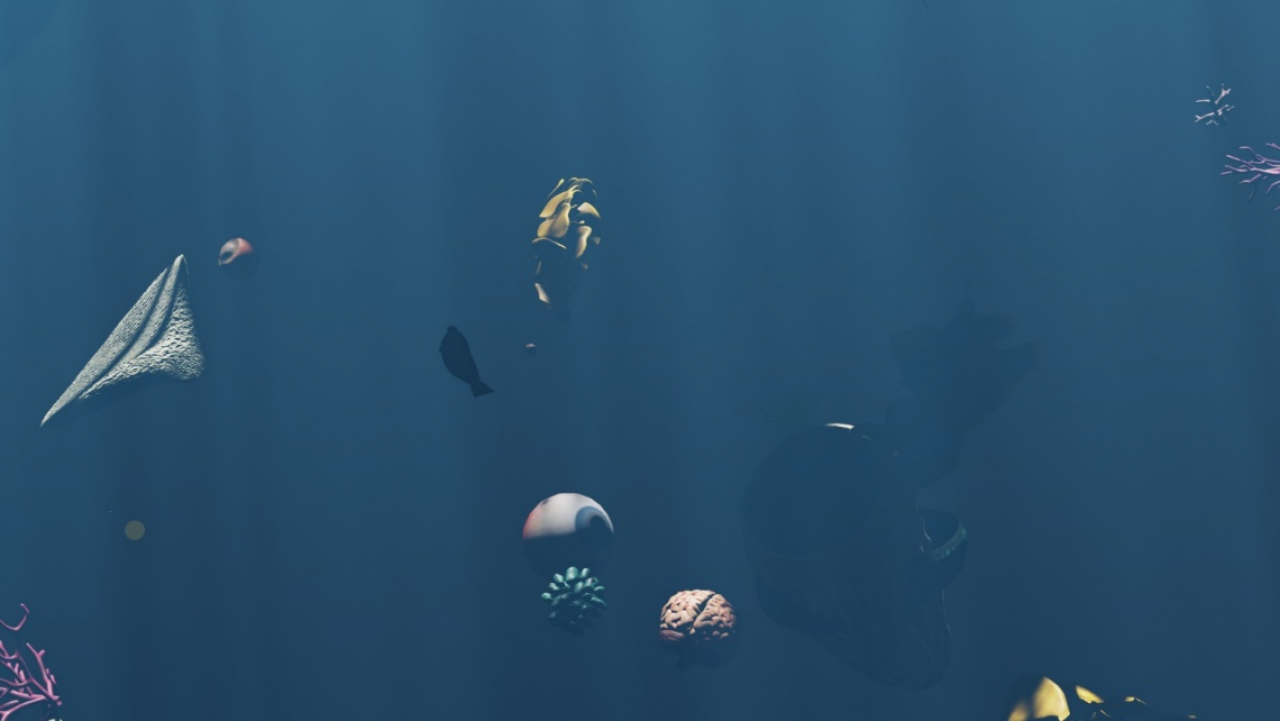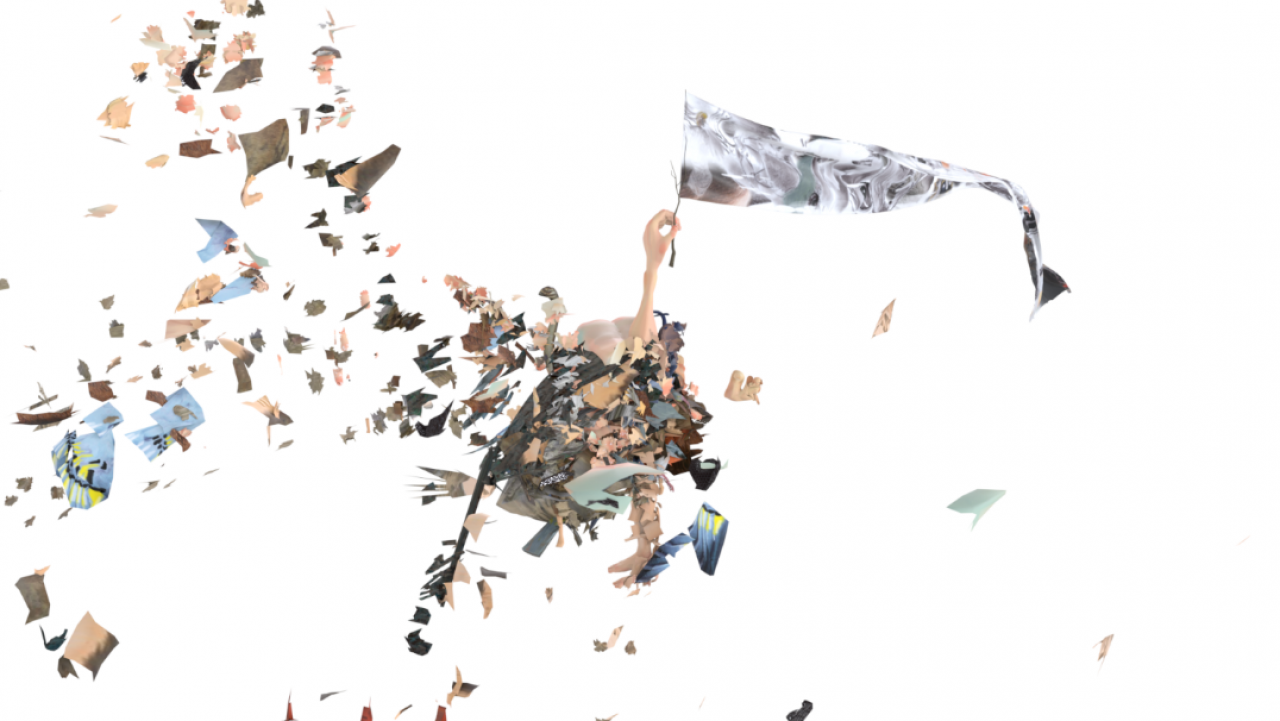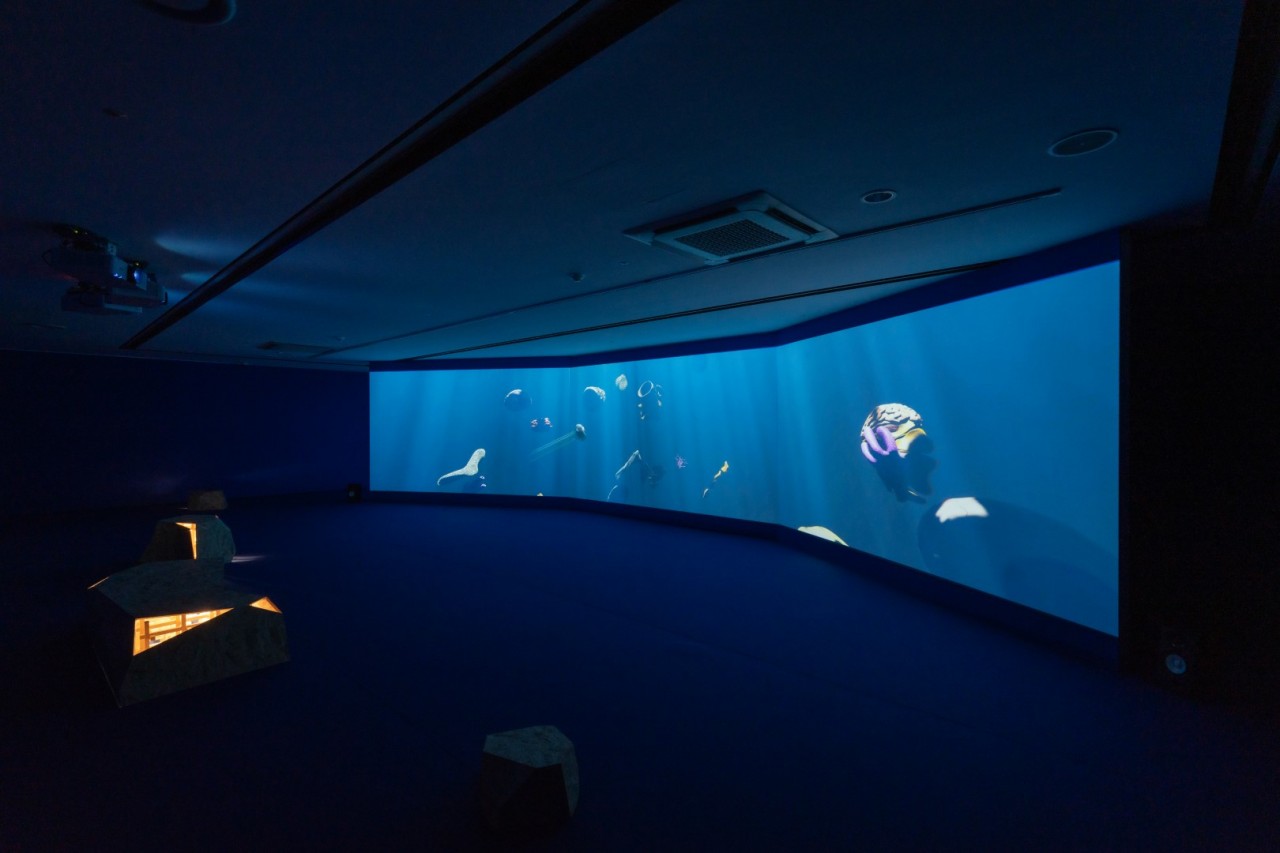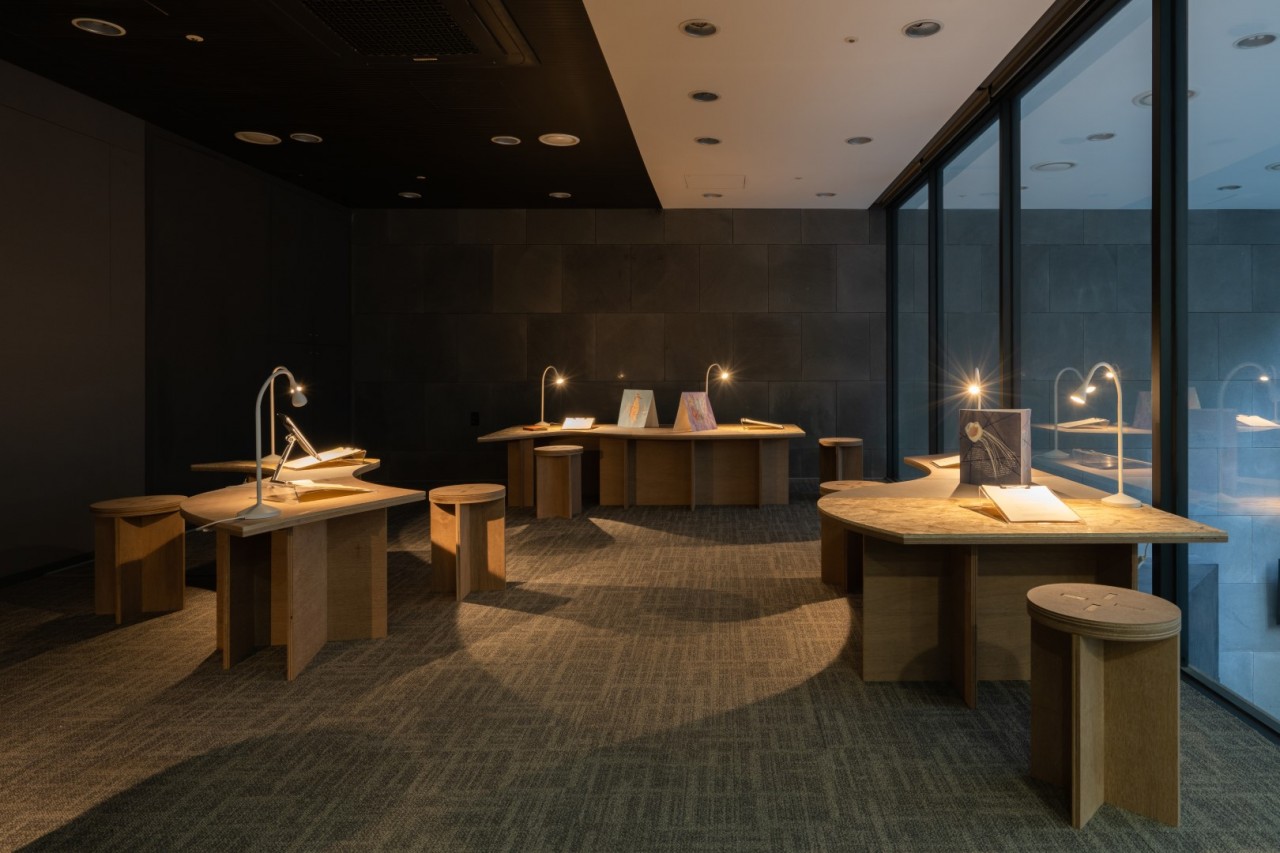Exhibitions

PERIGEE TEAM PROJECT 2021
트러블 트래블 Trouble Travel
2022.01.07. FRI ~
2022.02.12. SAT
<지구의 중간에서 만나기 Meeting the Earth Halfway¹>
유은순, 정혜정
작가 정혜정과 기획자 유은순은 지난 1년 간의 페리지 팀프로젝트 결과로 《트러블 트래블》을 선보인다. 우리 주변의 비인간-존재에 대해 꾸준하게 관심을 가지고 개인 작업 및 협업을 진행했던 정혜정과, 개인과 사회에서 주체와 타자의 이분법적 구분에 대해 의문을 가지고 수행적 정체성에 관심을 가진 유은순은 각자의 경험이 교차하는 지점에서 비인간-존재-되기에서 공통의 관심사를 발견하였다.
팀프로젝트 제목 《트러블 트래블》에서 ‘트러블(trouble)’은 도나 해러웨이의 『트러블과 함께하기』에서 차용하였다. 헤러웨이는 비인간-존재를 구분짓고 통제하는 인간중심주의적 관점을 해체하고 다른 언어와 삶의 방식을 가진 복수종이 “부분적인 회복”과 “함께 잘 지내기를 위한 평범한 가능성”에 마음을 쓰며 ‘트러블과 함께 하기(staying with the trouble)’라는 개념을 제시한다.² 이는 일원화된 질서나 보편성을 반대하고 지구에서 살아가는 다종다양한 존재가 얽히고 설켜 공-산(sympoiesis, 함께-만들기)하는 세계를 지향하며 존재들의 복수의 연결망을 생성해 나간다는 점에서 실천적 함의를 포함한다.³ ‘트래블(travel)’은 페리지팀프로젝트가 일....
Meeting the Earth Halfway¹
Eunsoon Yoo & Haejung Jung
Haejung Jung and Eunsoon Yoo present 《Trouble Travel》, the result of a yearlong Perigee Team project. Between Jung’s ongoing focus on the nonhuman-beings around us in her individual and collaborative work and Yoo’s interest in performative identity and questions about the subject/other dichotomy at the personal and social levels, the two of them discovered a common interest where their experiences intersect in the area of “becoming-nonhuman-being”
The “trouble” part of the title 'Trouble Travel' comes from Donna Haraway’s book 「Staying with the Trouble」. Deconstructing the anthropocentric perspective of distinguishing and controlling “nonhuman beings,” Haraway posits a concept of “staying with the trouble,” as “multispecies” possessing different languages and ways of living focus on “partial recuperation” and “getting on together.”² This includes a practical connotation, in the sense that it involves opposing unified orders and universality in favor of an orientation toward a world of sympoiesis among the ....
유은순, 정혜정
작가 정혜정과 기획자 유은순은 지난 1년 간의 페리지 팀프로젝트 결과로 《트러블 트래블》을 선보인다. 우리 주변의 비인간-존재에 대해 꾸준하게 관심을 가지고 개인 작업 및 협업을 진행했던 정혜정과, 개인과 사회에서 주체와 타자의 이분법적 구분에 대해 의문을 가지고 수행적 정체성에 관심을 가진 유은순은 각자의 경험이 교차하는 지점에서 비인간-존재-되기에서 공통의 관심사를 발견하였다.
팀프로젝트 제목 《트러블 트래블》에서 ‘트러블(trouble)’은 도나 해러웨이의 『트러블과 함께하기』에서 차용하였다. 헤러웨이는 비인간-존재를 구분짓고 통제하는 인간중심주의적 관점을 해체하고 다른 언어와 삶의 방식을 가진 복수종이 “부분적인 회복”과 “함께 잘 지내기를 위한 평범한 가능성”에 마음을 쓰며 ‘트러블과 함께 하기(staying with the trouble)’라는 개념을 제시한다.² 이는 일원화된 질서나 보편성을 반대하고 지구에서 살아가는 다종다양한 존재가 얽히고 설켜 공-산(sympoiesis, 함께-만들기)하는 세계를 지향하며 존재들의 복수의 연결망을 생성해 나간다는 점에서 실천적 함의를 포함한다.³ ‘트래블(travel)’은 페리지팀프로젝트가 일시적이며 함께하는 여정이라는 의미와, 비인간-존재-되기라는 노력이 기존에 구축된 질서를 버리는 과정이자 물리적, 심리적, 실천적으로 중심을 해체하는 과정이었다는 점에서 사용하였다.⁴《트러블 트래블》은 작가와 기획자가 1년 동안 일시적으로 팀을 이뤄 흔들리는 세계에서 느슨한 연결 고리를 가지고, 예술이 어떤 일을 할 수 있을지를 함께 고민하고 공유하는 여정으로써 그동안 세계와 예술의 중심에서 멀리 떨어져 있던 다종다양한 존재들의 목소리에 귀기울여보고 목소리를 함께 내고자 한다.
전시는 정혜정의 3채널 영상 <끝섬>(2021)과 관련 드로잉, 단채널 영상 <액체인간>(2021)과 유은순이 정혜정의 작업을 메타적/미시적으로 접근한 7개의 글, 유은순과 정혜정의 작업을 재해석한 4개의 테이블로 구성된다. 페리지 갤러리는 이번 전시에서 잠긴 물 속 세계로 가정되며 작업과 글, 가구 설치 등을 통해 인간-존재와 비인간-존재가 어떻게 서로 얽혀 있는지를 다각도로 그려낸다.
정혜정은 주체와 타자, 내부와 외부, 인간과 비인간 사이의 경계를 가로지르는 영상, 설치, 애니메이션, 프로젝트를 진행해왔다. 그는 단단하게 구분되어 있는 것처럼 보이는 것들 사이를 작가 자신의 몸으로 경험한다. 이를 통해 우리와 상관없어 보이는 먼 거리의 것들을 전시공간에 소환하고 재배치하여 보여줌으로써 거리를 좁히고 경계의 허구를 드러낸다. 정혜정의 작업은 마치 물과 같다. 작가의 작업에 바닷속, 한강과 같이 주제적으로도 물이 자주 등장하기는 하지만, 작가의 태도나 형식에 있어서도 물과 같은 측면이 있다. 작가는 끊임없이 유랑하며, 주제에서 다른 주제로 변주하며 작가의 아이덴티티를 고수하기보다 음악가, 무용가, 건축가, 디자이너, 프로그래머 등의 전문가부터 일반인들에 이르기까지 여러 사람들과 협업하며 프로젝트를 진행한다. 작가의 유연한 형식과 열려있는 태도는 작업주제적 측면과 일치한다.
정혜정의 과거 작업이 비인간-존재를 관찰하는 위치에 서 있었다면, 이번 팀프로젝트에서는 비인간-존재-되기 혹은 하기를 실천한다. 작가는 예술적 상상력을 가미하여 비인간-존재의 세계 인식 방법을 모방한다. 정혜정의 3채널 영상 <끝섬>은 이미 멸종된 동물들을 기억하기 위해 제작되었다. 이 작업에서 작가는 인간-존재인 자신이 비인간-존재가 '되기'를 적극적으로 상상해본다. 작가의 신체를 멸종 동물의 신체와 결합한 존재로 하이브리드 시키고, 이들이 세계를 어떻게 인식하고 감각하는지를 느껴본다. <끝섬>이 세계라는 거시적인 차원에서 인간-존재와 비인간-존재의 공생을 상상한다면, 단채널 영상 <액체인간>은 몸 속 세계라는 미시적인 차원에서 이미 비인간-존재가 깊이 개입하고 있음을 인식하는 작품이다. 두 작품에 등장하는 선으로 이루어진 아이는 거시적인 차원과 미시적인 차원을 횡단하며 우리의 몸과 세계가 불가분하게 얽혀 있음을 암시한다.
유은순은 신체에 내재한 타자성에서 시작하여 사회적 소수성, 정상과 비정상, 장애와 비장애 등 개인의 정체성을 구성하는 요소에 의문을 제기하고 수행성과 되어가는 것에 주목한 전시를 기획해 왔다. 그동안 그의 기획에서도 등장하곤 했던 주요한 개념인 ‘타자성’은 주체와 마찬가지로 고정된 것이 아니라 사회적 역할, 시간과 공간에 따라 계속 변화한다. 우리 역시 때로는 타자의 안쪽에 있거나 바깥에 놓이기도 한다. 몸이라는 공간 역시 인간이 유일한 몸의 주인이 아니라 다른 존재들과 공유하는 공간이며, 열려있고 통과할 수 있는 곳으로서 복잡하게 얽혀있다. 팀프로젝트를 하며 일년 동안 함께 이야기 나눈 과정은 수많은 그동안 의식하지 못했던 얽혀있는 타자의 ‘몸’들을 알아가는 시간이었다. 이번 팀프로젝트를 통해 유은순의 관심은 인간-존재와 비인간-존재로까지 확장된다.
유은순은 정혜정의 작업을 메타적/미시적으로 접근하며, 일련의 글을 통해 인간과 비인간의 관계를 재고한다. 유은순은 이번 작업에서 이러한 얽혀있는 열린 몸들을 여러 각도에서 조망한다. 그는 이를 위해 비평적인 글쓰기 뿐만 아니라 시적, 소설적, 에세이적 문체를 빌어 (SF적) 상상력을 가미한 글쓰기를 수행한다. 그것은 몸을 통과하는 물질적인 재료 ‘음식’부터 비물질의 세계로 비약적으로 뛰어넘는 상상이기도 하며, 실제로 지구라는 몸의 공유지대 안에서 어떻게 기후와 생물종이 변해왔는지를 살펴보는 데이터 자료, 그리고 기술문명의 발달로 뇌만 남게 되는 존재에 대한 이야기와 정혜정의 인간-동물되기 작업에 이입하는 글쓰기까지 주제를 종횡무진하며 경계를 가로지른다. 그가 그린 각기 다른 7개의 글은 어떤 부분에서는 꼬리에 꼬리를 무는 연결을 보여주며, 세계가 얼만큼 복잡하게 얽혀있는지를 글쓰기의 방식으로 보여준다. 글은 ‘나’라는 고정된 화자를 버리고 글의 주체를 달리함으로써 주체의 타자-되기를 실천하는 한편, 정혜정의 신작 <끝섬>과 <액체인간> 안에 어떤 존재를 위치시켜 그 세계를 이해하려고 시도한다.
글은 정혜정의 드로잉과 <끝섬>의 프롤로그영상과 함께 테이블 위에 비치된다. 노경택 작가와 협업한 테이블은 3개의 서로 다른 목재를 하나의 판으로 짠 다음 다시 4개로 조각 내어 테이블로 제작한 것이다. 테이블은 공간에 일종의 섬처럼 위치한다. 수면 위에서 서로 떨어져 존재하는 것 같은 섬도 해저에서는 하나의 땅으로 이어지듯이, 인간-존재와 비인간-존재가 서로 상호작용하며 연결되어 있는 세계를 은유한다. 정혜정과 유은순의 작업 역시 이와 마찬가지로 서로 긴밀하게 연결되어 있으며 근본적으로는 같은 지향점을 가진다.
코로나19가 우리 곁에 함께 한지도 어느새 2년이라는 시간이 흘렀다. 그것이 과연 갑작스러운 사건적 질병이었을까? 그 외에도 미세먼지, 에너지 위기, 식품 및 농업 위기, 플라스틱쓰레기에 이르기까지 우리 주변을 둘러싼 삶들의 곳곳에서 균열이 벌어지고 있다. 우리 주변을 둘러싼 개별적 사건들은 흩어져 있는 것처럼 보이지만, 사실 너무 거대해서 한 눈에 다 들어오지 않는다. 유은순과 정혜정은 이렇게 뒤죽박죽이고 조각난 것처럼 보이는 세계들이 사실 어떻게 복잡하게 상호작용하는지, 나의 몸이 다른 몸과 어떻게 얽혀있는지 감각하기 위해 촉수를 세우고 다른 존재를 이해하고자 하는 여정을 떠나고자 하며, 관객에게 이 여정을 함께하기를 제안한다.
_________________________________________
¹ 서문의 제목은 캐런 배러드의 저작 『우주의 중간에서 만나기 Meeting the Universe Halfway』를 살짝 비틀었다. 지정학에 기반한 인간중심주의적 위계를 벗어나면, 지구는 중심이 없으며 중심이 없는 지구에서 존재와 존재가 서로 이해하기 위해서는 서로의 중심으로 다가가기 위한 노력과 협력이 요청된다.
² 도나 해러웨이, 『트러블과 함께하기』, 최유미 옮김, 마농지, 2021, pp. 21-22.
³ ‘트러블(trouble)’은 르완다어 tera+ubura에서 기원한 것으로서, 똑바로 선 것이 흔들리는 것, 평정심이 흔들리는 것을 의미한다.
⁴정혜정과 유은순은 공통의 관심사에도 불구하고 서로의 입장에 차이가 있었지만 서로가 서로를 이해하기 위해 많은 대화를 나누었다. 정혜정과 유은순이 함께한 과정(travel)도 일종의 트러블(trouble)이었다.
Eunsoon Yoo & Haejung Jung
Haejung Jung and Eunsoon Yoo present 《Trouble Travel》, the result of a yearlong Perigee Team project. Between Jung’s ongoing focus on the nonhuman-beings around us in her individual and collaborative work and Yoo’s interest in performative identity and questions about the subject/other dichotomy at the personal and social levels, the two of them discovered a common interest where their experiences intersect in the area of “becoming-nonhuman-being”
The “trouble” part of the title 'Trouble Travel' comes from Donna Haraway’s book 「Staying with the Trouble」. Deconstructing the anthropocentric perspective of distinguishing and controlling “nonhuman beings,” Haraway posits a concept of “staying with the trouble,” as “multispecies” possessing different languages and ways of living focus on “partial recuperation” and “getting on together.”² This includes a practical connotation, in the sense that it involves opposing unified orders and universality in favor of an orientation toward a world of sympoiesis among the various entangled beings existing on earth and the formation of multiple connective networks among those beings.³ The “travel” part is used in the sense of the Perigee team project being both a temporary journey together, as well as the idea of the “becoming-nonhuman-being” effort being a process of casting aside the established order and deconstructing the center in physical, psychological, and practical terms.⁴《Trouble Travel》 is a journey in which an artist and curator team up temporarily over the course of a year to ponder and share the things that art is capable of achieving, adopting a loose linkage in a world of upheaval as they attempt to speak out together while they listen to the various beings that exist far away from the center of the world and art.
The exhibition consists of Jung’s three-channel video work <End Island> (2021) and associated drawings, her single-channel video <Liquid Person> (2021), seven texts in which Yoo approaches Jung’s work from a meta/micro level, and four tables that reinterpret both Yoo and Jung’s work. For this exhibition, Perigee Gallery is presumed to exist as an underwater world, using artwork, texts, and furniture installation to show in various ways how human-beings and nonhuman-beings are intertwined.
Haejung Jung has worked in videos, installations, animation, and projects that straddle the boundaries between subject and “other,” inside and outside, human and nonhuman. Through her own artist’s body, she experiences what exists in between things that seem rigidly distinguished. Summoning from afar things that appear unconnected with us and repositioning them in the exhibition setting, she narrows the gap and shows the fiction of boundaries. Her work is like water. Water does indeed appear often as a theme in her work, in forms such as the sea or the Han River, but there are also echoes of water in her approach and her forms. She is constantly roaming about, varying between one theme and another, and collaborating with various people in her projects—from experts such as musicians, dancers, architects, designers, and programmers to ordinary people—rather than adhering rigidly to her own identity as an artist. Her formal flexibility and open-ended approach are consistent with the thematic aspects of her work.
While Jung’s past work has placed her in the position of observing nonhuman-beings, this team project involves a practice of becoming or doing nonhuman-being. The artist includes an element of artistic imagination to mimic ways in which the nonhuman-being perceives the world. Her three-channel video End Island was created to remember animals that have gone extinct. For this work, she actively imagines her human-being self “becoming” a nonhuman-being. She hybridizes her own body into something merged with the extinct animal’s body, sensing how that animal understands and perceives the world. While <End Island> imagines human-being/nonhuman-being symbiosis at the large-scale level of the world, her single-channel video <Liquid Person> recognizes the ways in which nonhuman-beings already deeply permeate us at the small-scale level of the world within the body. The child rendered in lines in both works cuts across the large-scale and small-scale realms, alluding to the inextricable entanglement between our body and the world.
Starting from the otherness inherent to the body, Eunsoon Yoo has organized exhibitions that question the elements that comprise individual identity (social minority status, “normal” and “abnormal,” “disability” and “nondisability”) as they focus on performativity and becoming. “Otherness,” an important concept that has often appeared in her planning, is not fixed like the subject, but constantly changing according to social roles, times, and spaces. We too find ourselves placed either within or outside the “other.” The space that is the body is not governed by the human as sole master; it is a space shared with other things, a complex and intertwined space that is open and can be passed through. The process of sharing discussions over the team project’s yearlong duration was a time spent understanding the many intertwined “bodies” of others that we had not previously been conscious of. Through the project, Yoo’s interest has broadened to include human-beings and nonhuman-beings.
Yoo approaches Jung’s work at a meta/micro level, reconsidering the human/nonhuman relationship in her writings. She spotlights the open, entangled bodies in this work from multiple angles. Her writing is not merely critical; she also engages in writing flavored with (sci-fi) imagination, drawing on styles that are poetic, novelistic, and essaylike. Starting with food as a substance that passes through the body, this imagination takes off to arrive at a nonmaterial world, crossing boundaries and exploring everything from data showing how the climate and species have changed within the shared physical realm of the Earth to stories about technological developments that result in beings consisting solely of a brain, as well as texts that enter Jung’s process of human/animal becoming. The seven different texts she has rendered sometimes connect with each other in turn—a writing approach that shows how complex the world’s interlinkages are. Her writings practice “the subject becoming the other” as they abandon the idea of a fixed first-person narrator in favor of varied subjects, and she also places beings within Jung’s new works <End Island> and <Liquid Person> in an attempt to understand those worlds.
The texts are placed on tables alongside Jung’s drawings and the prolog video from <End Island>. Produced in collaboration with Kyungtaek Roh, the tables were created by weaving together three different kinds of wood into a single plank that was then split into four pieces. They occupy space like islands of a sort. Just as islands that appear separate over the water’s surface are actually joined underwater into a single land mass, this alludes to a world in which human-beings and nonhuman-beings are connected through their interactions. In the same way, Jung and Yoo’s work is closely interconnected, each of them sharing the same fundamental orientation.
The COVID-19 has now been part of our lives for two years. Was this contagion really a sudden “event”? Other cracks have started to form in our lives, in areas ranging from fine particle dust and the energy crisis to food and agriculture crises and plastic garbage. The individual events that surround us seem scattered, yet they are really too vast to be perceived all at once. To perceive all the complex interactions of worlds that appear chaotic and splintered, and how interconnected our bodies are with other bodies, Eunsoon Yoo and Haejung Jung raise their antennae on a journey to understand other beings—and they invite the viewer to join them on their travels.
_________________________________________
¹ The title of this introduction is a slight twist on the name of Karen Barad’s 「Meeting the Universe Halfway」. When we break away from the geopolitically founded anthropocentric hierarchy, the Earth has no center, and a centerless Earth requires efforts and cooperation for different beings to approach each other’s center in order to understand one another.
² Donna J. Haraway, 「Staying with the Trouble」, Duke University Press, 2016, p. 10.
³ The word “trouble” comes from the Rwandan 'tera+ubura', referring to the shaking or disrupted equilibrium of something standing upright.
⁴In spite of their common interests, Haejung Jung and Eunsoon Yoo also had their differences of perspective, but over the course of many conversations they each sought to understand the other. Their “travel” together was also a form of “trouble.”



